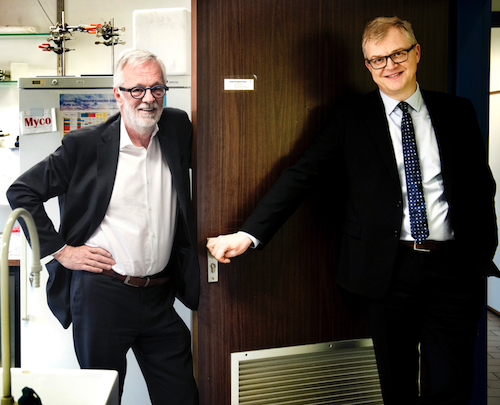With its expertise in mRNA production and knowledge of the biology of dendritic cells, eTheRNA has developed TriMix, a new mRNA technology platform. TriMix consists of a cocktail of three mRNAs, which pushes dendritic cells beyond their limits and helps them raise an immune response against cancer antigens. With TriMix, eTheRNA believes it has developed an incredibly versatile tool for cancer immunotherapy.
The origins of eTheRNA lie with the Vrije Universiteit Brussel (VUB) and its lab for Molecular and Cellular Therapy, headed by Prof. Kris Thielemans. Calling on Prof. Thielemans’ expertise in mRNA production, the VUB spun off eTheRNA as an mRNA production facility, serving academic institutions and small to mid-cap pharma companies. To this day, eTheRNA remains one of the only four GMP-accredited mRNA production units worldwide.
Since its foundation in 2013, eTheRNA has undergone a true transformation from production company to development biotech focused on oncology. In addition to mRNA production, Prof. Thielemans also set his knowledge of dendritic cells and their potential in cancer therapy to work. After testing the ability of different constructs and mixes of mRNAs to potentiate and activate dendritic cells, he found a unique mix of three mRNAs capable of just that. With its unique TriMix technology, the company set out to test this mRNA cocktail as a cancer therapy and eTheRNA 2.0 was born.
Recipe of the secret mix
As the first rationally designed platform to stimulate the immune system, TriMix facilitates the three steps in which dendritic cells assert their function:
- Dendritic cell activation, mediated by a molecular danger signal (e.g. DAMPs, PAMPs,…)
- Dendritic cell maturation, mediated by support signals from T helper cells (Th or CD4+ T cells)
- Activation of cytotoxic (CD8+) T cells by dendritic cells
The danger signal required for dendritic cell activation in the first step is simulated by expression of constitutive active Toll-like receptor 4 (caTLR4) mRNA. The second step, interaction with Th cells, is mediated by mRNA of CD40 ligand (CD40L). Finally, interaction with CD8+ T cells is enforced with mRNA of CD70. This unique combination of mRNA of caTLR4, CD40L and CD70 constitutes eTheRNA’s TriMix technology.
Cells or naked mRNAs?
Initially, to establish a proof of concept, TriMix was used to develop an ex vivo product. In this procedure, dendritic cells are extracted from a cancer patient’s blood and treated with the mix of mRNAs to prime them for therapy. Afterwards, the enhanced dendritic cells are readministered to the patient where they activate CD8+ T cells and stimulate them to destroy cancerous cells.
This strategy was clinically validated, in collaboration with Dr. B. Neyns at the University Hospital UZ Brussels, in four studies in patients with stage III to stage IV melanoma. These patients had previously gone through many different treatment options unsuccessfully and had very low life expectancies. eTheRNA’s CEO Dirk Reyn elaborates on the remarkable outcomes:
“We observed a 2-5% complete response in patients treated with the checkpoint inhibitor ipilimumab (Yervoy) in the VUB internal access program, which was completely in line with the data published by BMS. When combined with TriMix however, this percentage jumped to 20%. Similar beneficial effects were seen in patients where the primary melanoma tumor had been removed surgically. While 30% of the patients remained cancer-free after one year, 60% of patients receiving TriMix remained protected over a one year period.”
While the ex vivo cellular product has proven its merits in the clinic, eTheRNA is pursuing a different route with TriMix. Instead of treating isolated dendritic cells from the bloodstream, TriMix can also be directly injected into the neighborhood of dendritic cells to achieve the same effect in a much more patient-convenient, efficient and cost-effective way. This in vivo approach might offer several advantages for eTheRNA’s technology and is supported by an extensive set of preclinical data.
“The in vivo approach in which we directly inject our mRNA mix is a very scalable product,” explains Reyn. “TriMix is produced enzymatically and can be shipped easily to any location. This way, we can make TriMix a globally available, off-the-shelf and convenient to administer product. While the ex vivo approach for TriMix is without any doubt valuable, its applicability is more limited and we intend to develop the product for very personalized treatment based upon tumor profiling.”
Where to put the needle
With the four studies in melanoma patients having demonstrated the efficacy of the ex vivo product, eTheRNA now hopes to repeat this success with the in vivo product. To this end, three new studies will be initiated over the course of 2017, with another to follow in 2018.
When directly injecting TriMix into patients, two interesting options present themselves. The TriMix can either be injected directly into the tumor (intratumoral administration) or into the lymph nodes (intranodal administration). This choice may also determine whether tumor associated antigens (TAAs), or rather their mRNAs, should be added to TriMix. As TAAs are readily available in the tumor environment, adding them to the mix when administering directly into the tumor is believed to have little added value. This is not the case for injection into the lymph nodes, where tumor-specific material is absent and adding TAAs will help the dendritic cells to prime the cytotoxic T cells for the tumor type in question.
“Recently, data has been published showing the unique effects of intratumoral administration of different cancer drugs,” Reyn says. “Scientists are now realizing this could add a new dimension to cancer treatment that hadn’t been tested before. Of course, this requires the tumor to be accessible, which isn’t the case for all patients.”
In the coming years, eTheRNA will focus on demonstrating the efficacy of its in vivo product in both melanoma and triple negative breast cancer. Once this has been established, the company hopes to expand the applicability of this new platform technology to various other indications.
This article appears in the BioVox White Paper on Immunotherapy, May 2017. Download the complete work here for free.


